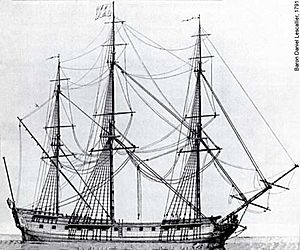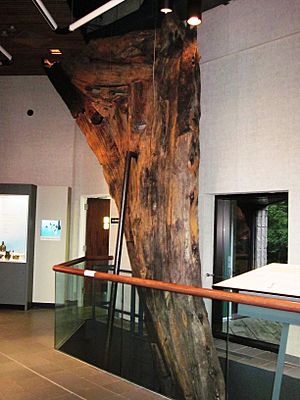Battle of Restigouche facts for kids
Quick facts for kids Battle of Restigouche |
|||||||
|---|---|---|---|---|---|---|---|
| Part of the French and Indian War | |||||||
 Illustration of the battle |
|||||||
|
|||||||
| Belligerents | |||||||
| Great Britain | France Mi'kmaq |
||||||
| Commanders and leaders | |||||||
| John Byron | Francois de Giraudais | ||||||
| Strength | |||||||
| 3 ships of the line 2 frigates |
1 frigate 5 merchantmen |
||||||
| Casualties and losses | |||||||
| 20 killed or wounded |
30 killed or wounded |
||||||
| Official name: Battle of the Restigouche National Historic Site of Canada | |||||||
| Designated: | 1924 | ||||||
The Battle of Restigouche was an important naval battle that happened in 1760. It was part of a bigger conflict called the Seven Years' War. In North America, this war was known as the French and Indian War. The battle took place on the Restigouche River. It was fought between the British Royal Navy and a smaller group of ships from the French Navy. These French ships were helped by Acadian and Mi'kmaq fighters.
The French ships were trying to bring supplies and help to their troops in New France. This was after the British had captured Quebec City in 1759. When the French lost these ships, it meant they could no longer seriously try to keep their colonies in North America. This battle was also the last big fight for the Mi'kmaq and Acadian militias. Soon after, the Mi'kmaq and British made peace in a special event called the Burying of the Hatchet Ceremony.
Contents
Why the Battle of Restigouche Happened
Quebec City, a very important French city, had fallen to the British in September 1759. This happened during the Battle of the Plains of Abraham. Even though Quebec was lost, many French soldiers were still in New France. These colonies relied completely on France for supplies and manufactured goods.
The French government was asked for more help, but they didn't send much. This was partly because the French navy had been badly beaten in November 1759.
French Ships Set Sail
On April 10, 1760, a French warship called Le Machault left France. It was led by Lieutenant Francois La Giraudais. Five merchant ships sailed with it. They carried 2,000 barrels of food and 400 soldiers. These soldiers were led by Francois-Gabriel D'Angeac, who knew the area well.
The ships had to spread out to get past a British blockade near France. Two merchant ships were captured. Another ran aground (got stuck) two weeks later. The three remaining ships met up in the Gulf of St. Lawrence on May 15. But they found that a British fleet had already reached Quebec.
Finding a Safe Harbor
Looking for a safe place, the French ships sailed to Chaleur Bay. On May 18, they anchored in the estuary of the Restigouche River. This was near the Mi'kmaq village of Listuguj. There, they got help from the local Mi'kmaq people and some Acadian refugees. In return, the French gave them food and weapons.
Meanwhile, British Royal Navy ships were sent to stop the French. These ships were led by Captain John Byron. They sailed from Louisbourg and arrived in Chaleur Bay on June 22. They blocked the bay, making it impossible for La Giraudais to escape.
La Giraudais responded by sailing his ships further up the river. The larger British ships would have trouble following in the shallower water. He turned Le Machault sideways to block the river. He also sank some smaller boats to create a barrier. On shore, he placed cannons to make his position stronger.
The Battle Begins
About 1,500 Acadian and Mi'kmaq fighters joined the French. The Acadians arrived in about 20 small boats. They went further up the river with the French. Their plan was to draw the British fleet closer to an Acadian village called Pointe-à-la-Batterie. Here, they hoped to surprise the British.
The Acadians sank more of their boats to create a blockade. The Acadian and Mi'kmaq fighters then fired at the British ships. On June 27, the British managed to get past the sunken ships. One British ship, HMS Norwich, almost sank. Once the British ships were close enough, they fired at the shore cannons. This fight lasted all night. It continued with breaks from June 28 to July 3.
British Push Forward
On July 3, the British finally took over Pointe-à-la-Batterie. They burned down 150 to 200 buildings in the Acadian village.
The Acadian and Mi'kmaq fighters retreated and joined up with Le Machault. They sank even more boats to create another blockade. They also set up two new cannon positions. One was on the north shore at Pointe de la Mission (now Listuguj, Quebec). The other was on the south shore at Pointe aux Sauvages (now Campbellton, New Brunswick).
On July 7, Captain Byron spent the day destroying the cannon position at Pointe aux Sauvages. He then returned to attack Le Machault. By the morning of July 8, two British ships, Scarborough and Repulse, were close to the blockade. They faced Le Machault. The British tried twice to defeat the shore cannons and the militias, but the militias held strong. On their third try, the British were successful.
The Final Stand
Even with La Giraudais' good positioning, Byron was able to move his ships through the shallower waters. On July 3, he faced the French defense line. The battle began at close range in calm weather. The French ships were outgunned, but they still caused a lot of damage to the British. Eventually, Byron managed to silence the shore cannons.
Le Machault and the merchant ships Bienfaisant and Marquis-de-Malauze then moved further upriver. The British followed them. For several days, the two sides fought a running battle. La Giraudais realized he couldn't win. On July 8, he ordered Le Machault and Bienfaisant to be sunk. This was to stop the British from capturing their valuable cargo. The Marquis-de-Malauze was saved because it held prisoners. The remaining French fighters went to shore and found safety in Listuguj. Byron then returned to Louisbourg.
What Happened After the Battle
The Battle of Restigouche ended with all the French ships and most of the Acadian boats sunk. However, the British could not land on shore because of the many muskets (guns) waiting for them. The Acadian and Mi'kmaq militias had made their final stand and survived.
Despite this, many Acadian settlers had to leave their homes and move elsewhere. By the next year, the Mi'kmaq and other local First Nations made peace treaties with Britain. These treaties promised peace and trade, and removed French influence.
The loss of important supplies for the French made it harder for New France to survive. Without help from outside, and surrounded by three different British forces, Montreal fell on September 8. La Giraudais finally surrendered on October 29. This was six days after he heard that Montreal had given up.
Captain Byron later led the British fleet that lost the Battle of Grenada in 1779. He also became the governor of Newfoundland.
Remembering the Battle Today
Today, the place where the battle happened is a National Historic Site of Canada. It is called the Battle of the Restigouche National Historic Site.
There is a special center in Pointe-à-la-Croix, Quebec. It shows items found from the battle site. There are displays and a film about the battle. You can also see a detailed model of Le Machault, the 18th-century French warship. In the summer, people dressed in costumes act as the Acadians, Micmaq, sailors, and French soldiers who fought in 1760.



